How STORYWORLD addresses learner variability
(Including specialized features for English Language Learners)
STORYWORLD’s team recognizes the importance of providing additional support for English Language Learners (ELLs) and students with different learning needs. Tools and features embedded within STORYWORLD’s learning system support four learning modalities: visual, auditory, reading/writing, and kinesthetic. Our broad range of multimodal, multilingual, and multisensory scaffolds give ELLs and students with other learning challenges a supportive learning experience.
Here are eight ways STORYWORLD provides support specifically for English Language Learners and English learners with learning variabilities:
1. Social/Emotional Support
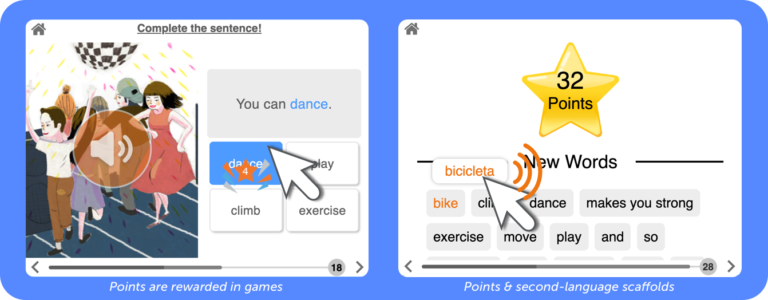
An abundance of research supports the conclusion that students are better learners when they feel socially and emotionally confident.1
We address this by…embedding auditory, text, and second-language scaffolds that students can activate on their own when needed. This enables them to learn the same material as their classmates, rather than be removed from the class for remediation. STORYWORLD’s entire learning experience includes rewards (points) for completing any quiz/game, therefore helping students feel emotionally confident as they progress through the material. STORYWORLD’s language scaffolds also support independent learning at school and home.
2. Cognitive Support
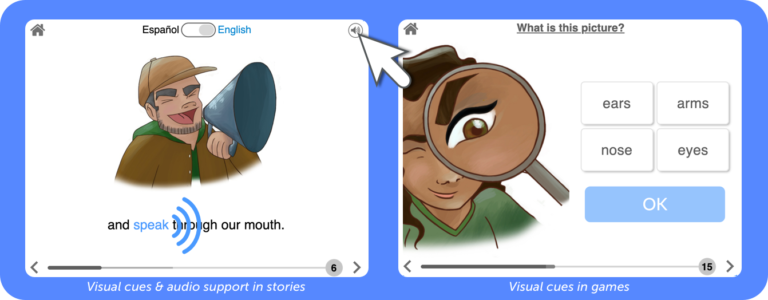
Though virtually all developing readers learn better with the addition of audio and visual supports, its benefits are even greater for ELLs and students with learning variabilities (such as auditory processing challenges). Numerous studies have shown that reading practice with audio support yielded improved reading results.2 Furthermore, a large body of research indicates that visual cues help the retrieval and storage of information.3 4
We address this by…having text in all stories and word books read aloud by native English speakers, and abundant visual clues to support cognition.
3. Students with different language backgrounds
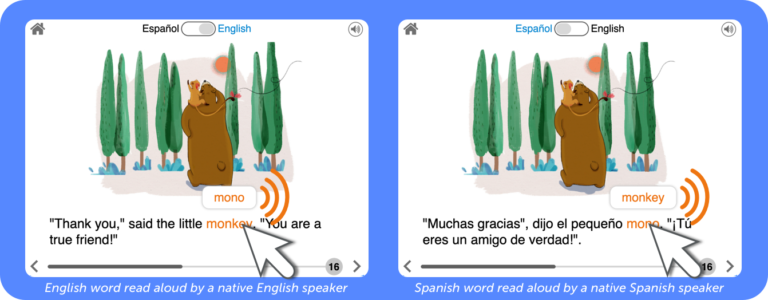
Students with different language backgrounds often understand key concepts very well, but language barriers may impede their ability to articulate what they know. This can lead to lower achievement over time.5
We address this by…providing embedded Spanish and Mandarin second-language support to all STORYWORLD text, with narration by native speakers. These supports enable students to receive a word-by-word translation in context, and translate the entire text for a fuller understanding whenever needed. Quiz-games at the end of the story also include text and audio instructions with native language scaffolds. For learners whose first language is not Spanish or Mandarin, every word or phrase and sentence is sounded out clearly in English.
4. Reading
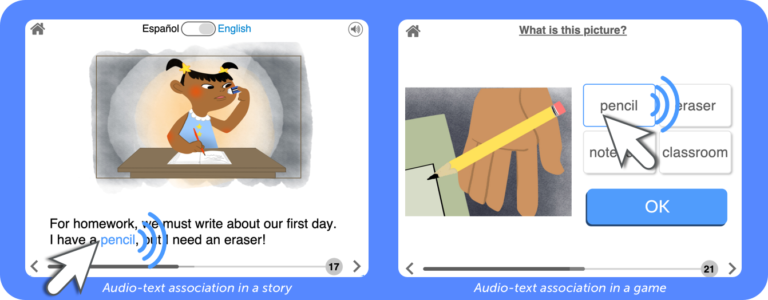
Words are the critical building blocks for reading. If too many words cannot be understood, students become frustrated and even turn off to reading altogether.6
We address this by…constantly associating the text with the sound of the word throughout our stories, word books, and quiz-games. As students interact with each word by clicking it—in both the narratives and in quiz-games—they use kinesthetic learning to reinforce audio & text connections.
5. Listening
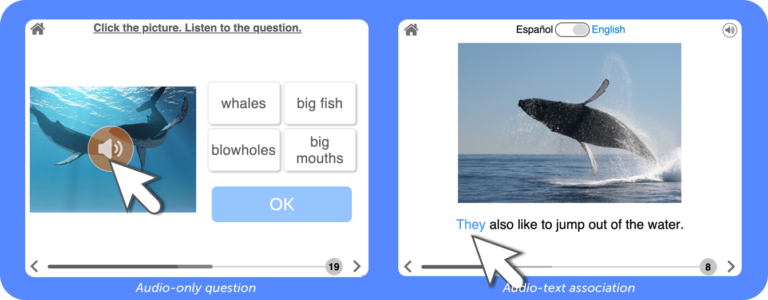
For ELLs and students with listening challenges, developing listening skills is extremely important. Listening skills must be well established for literacy skills to be imported from listening to reading.7
We address this by…always associating audio with text. Additional quiz-games include audio-only questions to encourage specific listening comprehension skills as part of the overall learning process.
6. Speaking
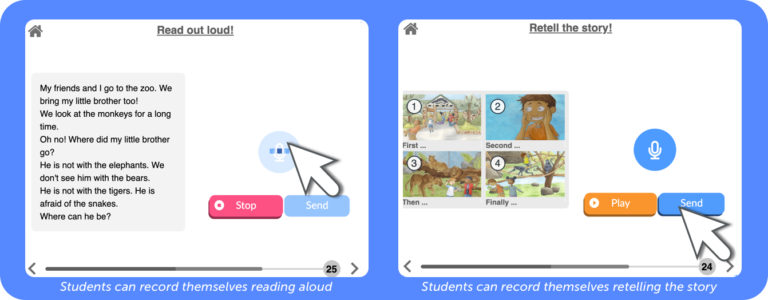
Oral proficiency is especially important for ELLs and students who may be delayed speakers. Oral proficiency builds confidence in English and is also associated with well-developed reading comprehension.8
We address this by…including opportunities in the quiz-games for students to record their own answers to prompts in different media: audio-only, written (with audio support), and audio (with written support.)
7. Writing
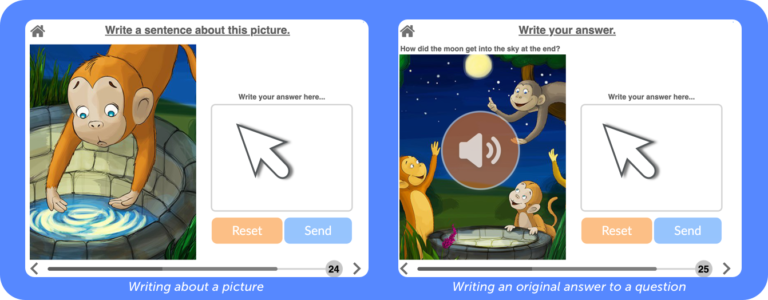
Experts agree that writing practice that extends and deepens understanding of the material should start as soon as possible.9 For some students (especially those with different language backgrounds), writing may be a more comfortable way of expressing their understanding of the material at first. There is evidence that allowing second-language learners to pre-write and brainstorm in their native language results in higher-quality writing in the target language during later stages of the writing process.10
We address this by…including opportunities in quiz-games for students to write answers—in whatever language they choose—to prompts in different media: audio-only, written (with audio support), and audio (with written support.)
8. Supports for educators
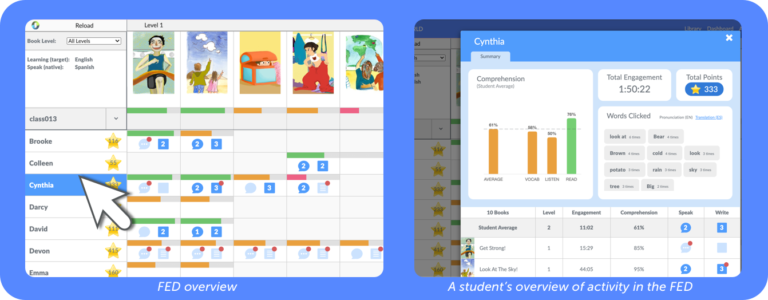
Research shows that teachers can better intervene with meaningful support for each student when provided with actionable data in real-time.11 This is especially important when working with students with learning variabilities.
We address this by…designing STORYWORLD’s Formative Evaluation Dashboard (FED) to captures each student’s overall activity and identify specific areas of strengths and learning challenges for all 4 English language modalities (reading, listening, writing, speaking), as well as vocabulary. STORYWORLD’s FED enables teachers to report and track written and spoken contributions for each story according to standards.
The Dashboard also measures student motivation to learn, displayed as a function of engagement/time spent on each story. The Dashboard also enables the educator to assess understanding of the subject area through depth-of-knowledge and inference questions.
Because specific information for each student is reported through the Dashboard according to each modality (reading, listening, writing, and speaking), STORYWORLD’s FED is especially helpful in identifying and addressing the specific learning challenges of each student at risk of falling behind.
References
(1) Bear, G.G., Whitcomb, S.A., Elias, M.J., & Blank, J.C. (2015). “SEL and Schoolwide Positive Behavioral Interventions and Supports.” In J.A. Durlak, C.E. Domitrovich, R.P. Weissberg, & T.P. Gullotta (Eds.), Handbook of Social and Emotional Learning. New York: Guilford Press.
(2) Verdi, M. P., Johnson, J. T., Stock, W. A., Kulhavy, R. W., Whitman-Ahern, P. (1997). Organized spatial displays and texts: Effects of presentation order and display type on learning outcomes. Journal of Experimental Education, 65, 303-317.
(3) Mayer, R. E., & Moreno, R. (1998). A split-attention effect in multimedia learning: Evidence for dual processing systems in working memory. Journal of educational psychology, 90(2), 312.
(4) Mayer, R. E., & Sims, V. K. (1994). For whom is a picture worth a thousand words? Extensions of a dual-coding theory of multimedia learning. Journal of educational psychology, 86(3), 389.
(5) Ferlazzo, L., Sypnieski, K. H., The ESL/ELL Teacher’s Survival Guide, John Wiley and Sons Inc; 1 edition (2012).
(6) Echevarria, J., Vogt, M., & Short, D.J. (2004). Making content comprehensible for English learners: The SIOP model (2nd ed.), p.49. Boston: Pearson.
(7) Yaghoub Zadeh, Z., Farnia, F., & Geva, E. (2012). Toward Modeling Reading Comprehension and Reading Fluency in English Language Learners. Reading and Writing: An Interdisciplinary Journal, 25, 163-187.
(8) Institute of Education Sciences (IES), National Center for Education Evaluation and Regional Assistance (NCEE), (2014) Teaching Academic Content and Literacy to English Learners in Elementary and Middle School. U.S. Department of Education.
(9) Lems, K., Miller, L., Soro, T. (2017). Building Literacy with English Language Learners: Insights from Linguistics (2nd ed). New York, NY: Guilford Press.
(10) Hall, G., & Cook, G. (2012). Own-language use in language teaching and learning: state of the art. Language teaching, 45(3), 271-308.
(11) Samson, J.F., & Collins B.A. (2012). Preparing all teachers to meet the needs of English language learners. Center for American Progress. Retrieved from http://files.eric.ed.gov/fulltext/ED535608.pdf.